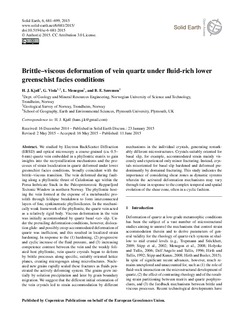| dc.contributor.author | Kjøll, Hans Jørgen | |
| dc.contributor.author | Viola, Giulio | |
| dc.contributor.author | Menegon, Luca | |
| dc.contributor.author | Sørensen, Bjørn Eske | |
| dc.date.accessioned | 2019-11-25T07:31:03Z | |
| dc.date.available | 2019-11-25T07:31:03Z | |
| dc.date.created | 2015-08-17T14:36:09Z | |
| dc.date.issued | 2015 | |
| dc.identifier.citation | Solid Earth (SE). 2015, 6 (2), 681-699. | nb_NO |
| dc.identifier.issn | 1869-9510 | |
| dc.identifier.uri | http://hdl.handle.net/11250/2630158 | |
| dc.description.abstract | We studied by Electron BackScatter Diffraction (EBSD) and optical microscopy a coarse-grained (ca. 0.5–6 mm) quartz vein embedded in a phyllonitic matrix to gain insights into the recrystallization mechanisms and the processes of strain localization in quartz deformed under lower greenschist facies conditions, broadly coincident with the brittle–viscous transition. The vein deformed during faulting along a phyllonitic thrust of Caledonian age within the Porsa Imbricate Stack in the Paleoproterozoic Repparfjord Tectonic Window in northern Norway. The phyllonite hosting the vein formed at the expense of a metabasaltic protolith through feldspar breakdown to form interconnected layers of fine, synkinematic phyllosilicates. In the mechanically weak framework of the phyllonite, the quartz vein acted as a relatively rigid body. Viscous deformation in the vein was initially accommodated by quartz basal slip. Under the prevailing deformation conditions, however, dislocation glide- and possibly creep-accommodated deformation of quartz was inefficient, and this resulted in localized strain hardening. In response to the (1) hardening, (2) progressive and cyclic increase of the fluid pressure, and (3) increasing competence contrast between the vein and the weakly foliated host phyllonite, vein quartz crystals began to deform by brittle processes along specific, suitably oriented lattice planes, creating microgouges along microfractures. Nucleated new grains rapidly sealed these fractures as fluids penetrated the actively deforming system. The grains grew initially by solution precipitation and later by grain boundary migration. We suggest that the different initial orientation of the vein crystals led to strain accommodation by different mechanisms in the individual crystals, generating remarkably different microstructures. Crystals suitably oriented for basal slip, for example, accommodated strain mainly viscously and experienced only minor fracturing. Instead, crystals misoriented for basal slip hardened and deformed predominantly by domainal fracturing. This study indicates the importance of considering shear zones as dynamic systems wherein the activated deformation mechanisms may vary through time in response to the complex temporal and spatial evolution of the shear zone, often in a cyclic fashion. | nb_NO |
| dc.language.iso | eng | nb_NO |
| dc.publisher | European Geosciences Union | nb_NO |
| dc.rights | Navngivelse 4.0 Internasjonal | * |
| dc.rights.uri | http://creativecommons.org/licenses/by/4.0/deed.no | * |
| dc.title | Brittle-viscous deformation of vein quartz under fluid-rich lower greenschist facies conditions | nb_NO |
| dc.type | Journal article | nb_NO |
| dc.type | Peer reviewed | nb_NO |
| dc.description.version | publishedVersion | nb_NO |
| dc.source.pagenumber | 681-699 | nb_NO |
| dc.source.volume | 6 | nb_NO |
| dc.source.journal | Solid Earth (SE) | nb_NO |
| dc.source.issue | 2 | nb_NO |
| dc.identifier.doi | 10.5194/se-6-681-2015 | |
| dc.identifier.cristin | 1258434 | |
| dc.description.localcode | © Author(s) 2015. This work is distributed under the Creative Commons Attribution 3.0 License. CC-BY | nb_NO |
| cristin.unitcode | 194,64,90,0 | |
| cristin.unitname | Institutt for geovitenskap og petroleum | |
| cristin.ispublished | true | |
| cristin.fulltext | original | |
| cristin.qualitycode | 1 | |

